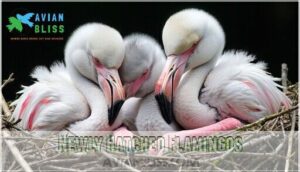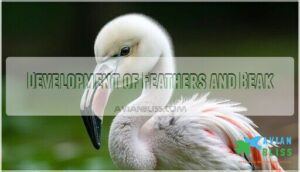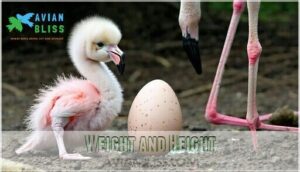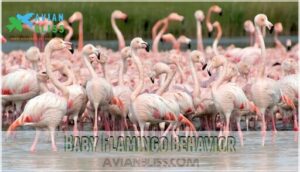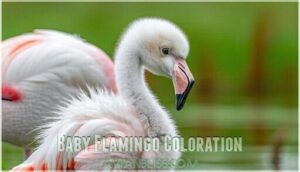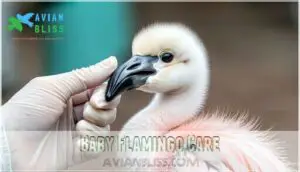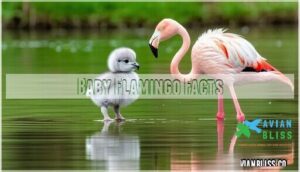This site is supported by our readers. We may earn a commission, at no cost to you, if you purchase through links.
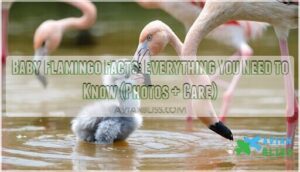
These fluffy gray chicks, weighing just 2-3 ounces at hatching, look nothing like their vibrant parents.
They’re born with straight beaks and depend entirely on their parents’ special crop milk for the first few weeks.
This nutrient-rich secretion helps them grow rapidly, gaining about an ounce daily.
Their iconic curved beak develops around six weeks, while their famous pink coloration takes months to appear through their diet of algae and small crustaceans.
The transformation from gray fluffball to elegant pink wader involves fascinating developmental stages.
Table Of Contents
- Key Takeaways
- Baby Flamingo Appearance
- Baby Flamingo Size
- Baby Flamingo Diet
- Baby Flamingo Growth
- Baby Flamingo Behavior
- Baby Flamingo Coloration
- Baby Flamingo Development
- Baby Flamingo Care
- Baby Flamingo Socialization
- Baby Flamingo Facts
- Frequently Asked Questions (FAQs)
- When do baby flamingos fledge?
- How does Baby Flamingo reunite with its family?
- When do baby flamingos eat?
- How many babies do flamingos have per year?
- What is a baby flamingo called?
- How much do baby flamingos weigh?
- What do baby flamingos eat?
- Where do baby flamingos live?
- What are flamingo babies called?
- How do baby flamingos turn pink?
- Conclusion
Key Takeaways
- You’ll be surprised to learn that baby flamingos start life as gray or white fluffy chicks, not pink, and won’t develop their famous pink coloration until they’re 2-3 years old through carotenoids in their diet.
- You’ll notice baby flamingos depend entirely on their parents’ red crop milk for the first 6 weeks of life, which provides all essential nutrients and helps them gain about an ounce daily.
- You’ll see dramatic physical changes as baby flamingos develop – their straight beaks curve by 11 weeks for filter feeding, their thick pink legs turn black within 10 days, and they’re ready to fly around 10-12 weeks old.
- You’ll find baby flamingos are incredibly social creatures that join large protective groups called crèches at 3 weeks old, where they learn survival skills by copying adult behaviors while parents can still identify their own chick’s unique call among thousands.
Baby Flamingo Appearance
You’ll notice baby flamingos look nothing like their bright pink parents when they first hatch, appearing almost completely white or gray with fluffy down feathers.
These tiny fluffballs start life looking like miniature storm clouds before transforming into vibrant pink dancers.
These chicks have straight, short beaks and thick pink legs that gradually change color and shape as they grow into their iconic adult form.
Newly Hatched Flamingos
When your flamingo chick first hatches, you’ll notice it’s surprisingly different from its vibrant parents.
These flamingo hatchlings emerge with soft downy plumage that’s grey or white, not pink.
Each flaminglet weighs about 73-90 grams and has pink legs that appear thick and swollen.
Their straight bills are red or pink, lacking the distinctive curved shape of adults.
Development of Feathers and Beak
Watching feather development in flamingo chicks reveals nature’s incredible transformation.
Your flamingo chick starts with soft downy plumage that’s gray or white.
Around four weeks, darker gray feathers replace the initial fluff.
The straight beak gradually develops its signature curvature by eleven weeks, becoming perfect for filter feeding.
Flight feathers emerge around this time, preparing chicks for their first aerial adventures.
Leg Color and Shape
Baby flamingo chicks start life with thick, swollen pink legs that look almost cartoonish.
The swelling timeline shows these puffy limbs slim down within 48 hours after hatching.
Around seven to ten days old, dramatic leg pigmentation changes occur – those pink juvenile legs turn completely black.
This striking transformation from pink to black legs happens alongside their greyish-white coloured beak development in flamingo chicks.
Juvenile Flamingo Characteristics
Growing flamingo chicks transform dramatically during their weaning stage.
You’ll notice juvenile flamingos sport distinctly different features from their parents, making them easy to identify in the wild.
Here are the key characteristics of juvenile flamingos:
- Grey plumage – Fluffy grey coloured feathers cover their entire body instead of pink
- Black legs – Dark-colored legs that contrast sharply with adult flamingos’ bright pink limbs
- Beak coloration – Greyish-white beaks with grey eye color complete their understated appearance
Baby Flamingo Size
When you first see a baby flamingo, you’ll notice they’re surprisingly small, weighing only about 73 to 90 grams at hatching, which is roughly the size of a tennis ball with tiny legs.
These compact chicks will grow dramatically over the next few years, eventually reaching their adult height of 3 to 5 feet and weight of 4 to 8 pounds, which is a significant increase in size, making them a notable example of dramatic growth.
Weight and Height
When flamingo chicks hatch, they’re surprisingly tiny—weighing just 73-90 grams, about the size of a tennis ball with legs.
Their egg size ranges from 115-140 grams, making the hatchling weight roughly half their original shell home.
These baby flamingo youngsters grow rapidly, with their growth rate accelerating as they develop, showing dramatic changes from their compact beginnings.
Comparatively, baby peacocks weigh around 103 grams at birth, highlighting the size variation among different bird species, with flamingos exhibiting a notable height variation among their development stages.
Comparison to Adult Flamingos
Picture a tennis ball sprouting skinny legs next to a graceful ballet dancer – that’s your size comparison between baby flamingo chicks and adults.
Juvenile flamingo development shows dramatic changes: thick, swollen legs slim down, straight beaks develop curvature for feeding independence, and fluffy gray plumage differences transform into vibrant pink adult feathers.
Color development takes years to complete.
Baby Flamingo Diet
You’ll discover that baby flamingos don’t eat regular food like adults do, but instead receive a special red substance called crop milk from their parents.
This nutrient-rich milk provides everything the chicks need to grow strong and healthy during their first few weeks of life, which is a complete concept in the development of flamingos.
Crop Milk Composition
When you examine flamingo crop milk, you’ll discover it’s remarkably similar to a mother’s milk.
This red-colored substance contains essential nutrients that baby flamingos need for healthy development.
The crop milk composition includes:
- Lipid Content – High fat levels for energy and growth
- Protein Ratios – Essential amino acids for muscle development
- Glucose Levels – Quick energy source for active flamingo chicks
- Carotenoid Source – Pigments that eventually create pink coloration
This parental investment guarantees superior nutrition.
Feeding Habits of Baby Flamingos
You’ll notice flamingo chicks have fascinating feeding habits that center around their parents’ dedication.
Both mom and dad take turns regurgitating crop milk directly into their baby’s mouth.
This feeding frequency happens multiple times daily for the first six weeks.
The flamingo chick depends entirely on this nutrient-rich milk, with parents alternating feeding duties to guarantee consistent nourishment throughout development.
Transition to Solid Food
The weaning timeline for flamingo chicks marks a pivotal developmental milestone between 4-6 weeks of age.
During this critical phase, their beaks develop enough filtration capability to process solid food independently.
Here’s how flamingo growth progresses during this vital phase:
- Beak readiness – Curved filtering structures fully develop by weaning time
- Parental influence – Adults gradually reduce crop milk regurgitation frequency
- Foraging independence – Chicks begin practicing plankton filtering techniques
- Diet diversity – Solid foods include algae, insects, and small aquatic creatures
- Nutrient absorption – Digestive systems adapt to process varied flamingo diet components
The provided list outlines key aspects of flamingo development during the weaning phase, highlighting the importance of this period for their growth and survival.
Importance of Carotenoid-Rich Diet
Carotenoid-rich crop milk provides essential alpha and beta carotenoid pigments that determine your baby flamingo’s future pink plumage.
Without proper pigment absorption from dietary sources like canthaxanthin, flaminglets won’t develop their signature feather color.
This flamingo diet also offers vital health benefits, supporting immune function and overall development.
You’ll notice stronger, more vibrant birds when carotenoids are abundant, and this leads to a healthier overall state with better immune function.
Baby Flamingo Growth
You’ll notice that baby flamingos grow at a steady pace, gaining weight and developing motor skills over their first few months of life.
These chicks reach important milestones quickly, from joining group nurseries at three weeks to taking their first flights around eleven weeks old.
Weight Gain and Growth Rate
When baby flamingo chicks hatch, they’ll tip the scales at just 73-90 grams—about the weight of three golf balls.
Their bird growth follows a steady upward climb, gaining roughly 10% of their body weight daily during those vital first weeks.
Newly hatched chicks initially have soft downy feathers.
- Hatchling weight starts incredibly light at 2.5-3.2 ounces but doubles within weeks
- Growth milestones include reaching flight readiness around 11 weeks old
- Dietary impact from crop milk fuels their rapid weight gain and development
- Adult size varies dramatically—Greater Flamingos reach 7.7 pounds while Lesser Flamingos stay around 5.5 pounds
- Weight variation between flamingo species reflects their different ecological niches and survival strategies
Development of Motor Skills
Young flamingo chicks master early locomotion within their first week, stumbling around like toddlers finding their sea legs.
Their foraging skills improve through hunting imitation of adults, while creche coordination helps them navigate group dynamics.
You’ll watch them develop flight coordination as their wings strengthen around 11 weeks, and bird development follows predictable patterns as flamingo growth accelerates during these pivotal motor skill milestones.
Socialization and Interaction
As your baby flamingo grows stronger, it craves company like kids need playmates.
Around three weeks old, chicks join a crèche where Creche Dynamics shape their world.
Through Mimicry Learning, they copy adults’ feeding techniques while developing Vocal Communication skills.
Parental Recognition remains strong—parents still identify their chick’s unique call among hundreds.
This social behavior builds confidence for future Flock Integration.
Milestones in Flamingo Development
Flamingo chicks follow a predictable timeline from egg incubation through sexual maturity.
Your flaminglet will hatch after 30 days, join crèche integration at three weeks, and enter the weaning period by six weeks.
Flight attainment occurs around 11-12 weeks, while juvenile flamingo development continues for years.
Bird maturation reaches sexual maturity between 3-5 years of age.
Baby Flamingo Behavior
You’ll notice baby flamingos display fascinating social behaviors from just a few weeks old, when they join large groups called crèches for protection and learning.
These young birds actively copy adult hunting techniques while playing and exploring together, which helps them develop the skills they’ll need to find food on their own, using techniques they learned.
Parental Care and Supervision
Both parents share responsibility for raising their baby flamingo through an intricate system of care and protection.
You’ll find that flamingo parents use voice recognition to identify their chick among thousands in the colony. They regurgitate nutrient-rich crop milk directly into their offspring’s mouth, ensuring proper nutrition during those critical early weeks. Male flamingos, like bluebirds, also supply protein-rich insects to their offspring.
Here’s what makes flamingo parental care remarkable:
- Voice recognition – Parents can identify their specific chick’s call among thousands of other young flamingos in the colony
- Shared feeding duties – Both mother and father take turns producing and delivering crop milk to their offspring
- Crèche protection – Adults work together to supervise large groups of young flamingos while parents forage for food
- Teaching through mimicry learning – Parents demonstrate proper feeding techniques that chicks copy to develop essential survival skills
Interaction With Other Flamingos
Within crèche dynamics, baby flamingo chicks quickly learn social hierarchy through mimicry learning from older birds.
You’ll observe how adult protection creates safe spaces where young flamingos practice flamingo behavior patterns.
During flamingo breeding season, parental care extends beyond biological parents as the entire flock helps with supervision, which guarantees successful flock integration for developing chicks through a collaborative approach.
Learning to Hunt and Forage
How do baby flamingo chicks master the art of finding food?
Around 30 days old, these flaminglets begin their diet shift through mimicry learning, copying adults in their crèche foraging groups.
While independent feeding starts developing, their beaks lack proper filtering structures for effective prey selection.
Most chicks continue receiving parental feeding until they fully fledge from the crèche.
Juvenile flamingos exhibit age-related association choices, preferring to interact with similar-aged peers, which is a key part of their social development and mimicry learning process, and helps them master the art of finding food.
Importance of Social Interaction
Social bonds act like a security blanket for flaminglets, providing essential crèche benefits that guarantee survival.
You’ll notice how mimicry learning happens naturally when chicks observe adults, developing vital communication skills through constant interaction.
This bird social structure offers social protection while teaching proper bird behavior. Successful flock integration depends entirely on these early social experiences, making bird parenting a community effort.
Baby Flamingo Coloration
You might wonder why baby flamingos aren’t born with their famous pink feathers, and the answer lies in their diet and development.
These chicks start life with gray or white downy feathers, then gradually develop their pink coloration over two to three years through carotenoid pigments from their food.
Origin of Pink Coloration
Here’s the origin story that’ll blow your mind: baby flamingo pink color development doesn’t happen overnight.
These little ones start life completely white or gray, then gradually transform through dietary carotenoids found in algae and shrimp.
Their parents’ crop milk contains concentrated carotene that begins the pigment absorption process.
Genetic factors determine how efficiently each flamingo processes these color-boosting compounds.
Role of Carotenoid Pigments
Carotenoid pigments work like nature’s paintbrush for your baby flamingo’s transformation.
These powerful compounds from dietary sources get absorbed into developing feathers, creating that iconic pink color. The pigment absorption process directly affects color intensity – more carotene means brighter pink feathers.
These pigments also provide health benefits beyond pigmentation, supporting your flamingo’s immune system and overall development through their antioxidant properties.
Factors Affecting Coloration
Several factors influence your baby flamingo’s pink color development beyond carotenoid pigments.
Diet quality affects pigmentation intensity, while genetic predisposition determines color potential.
Habitat influence plays a role through available food sources, and age variation creates different coloration stages.
Crop milk provides initial carotene exposure, establishing the foundation for future color development.
Key factors affecting baby flamingo coloration include:
- Dietary Carotenoids – Alpha and beta carotenoids from algae and shrimp determine color intensity
- Genetic Predisposition – Individual birds have varying capacities for pigment absorption and display
- Habitat Influence – Water quality and food availability in their environment affects pigmentation
- Age Variation – Coloration develops gradually over 2-5 years, with younger birds showing less pink
Coloration in Juvenile Flamingos
Juvenile flamingos start their color journey looking like fluffy gray clouds.
You’ll notice their pigmentation develops gradually through dietary influence and pigment absorption.
A baby flamingo’s pink feathers emerge over 2-3 years as carotene from their diet works its magic on flamingo plumage.
| Age Range | Coloration | Carotene Level |
|---|---|---|
| 0-6 months | Gray/White | Minimal |
| 6-18 months | Light Pink | Developing |
| 18+ months | Pink/Orange | Established |
| Adult | Bright Pink | Maximum |
Genetic factors and environmental impact also shape their coloration timeline, making each bird’s transformation unique, influenced by carotene and overall pigmentation development.
Baby Flamingo Development
You’ll watch baby flamingos transform from gray, fluffy chicks into elegant pink birds through several key developmental stages.
Their beaks curve at 11 weeks, flight feathers appear around the same time, and their legs change from pink to black within the first ten days of life, which are complete concepts that highlight the transformation process, including the development of flight feathers.
Flight Development
Baby flamingos develop flight feathers around 11 weeks after bird hatching.
You’ll notice their first flights happen between two to three months of age, marking an exciting milestone in bird development.
- Flight feathers appear gradually during weeks 9-11
- Flamingo chicks practice wing movements before actual bird flight
- First flights are short, clumsy attempts at independent soaring
- Fledging timeline completes when chicks master sustained flight at 10-12 weeks
Beak Development
A baby flamingo’s beak undergoes remarkable transformation, with complete concepts of development being crucial.
Hatchlings start with straight bills that are red-pink at birth, then turn greyish-white within days.
The curved beak essential for filter feeding develops gradually, reaching full curvature by the weaning stage.
This beak morphology change allows efficient mud scooping and prey extraction once they’re independent.
| Development Stage | Beak Characteristics |
|---|---|
| Newly Hatched | Short, straight red-pink bills |
| 7-10 Days | Greyish-white coloured beak |
| 11 Weeks | Beak curvature begins |
| Weaning Stage | Fully curved beak for filter feeding |
The development stages are clearly outlined, showing the progression from a straight bill to a fully curved beak.
Understanding these stages is key to appreciating the remarkable transformation of a baby flamingo’s beak.
Leg Development
Young flamingo chicks start life with thick, swollen pink legs that gradually transform as they grow.
You’ll notice the leg swelling decreases within 48 hours after hatching, while bone growth strengthens their walking ability and leg strength develops rapidly.
Here’s how flaminglet leg development progresses:
- Initial swelling reduces substantially after two days
- Bone growth accelerates during the first month
- Walking ability improves as muscles strengthen
- Foot structure adapts for wading and filter-feeding
Feather Development
Feather development in flamingos happens in distinct stages that’ll amaze you.
Downy plumage covers newborns in soft gray-white fluff, providing warmth and protection.
Around four weeks, these downy feathers darken, then juvenile plumage emerges at six months with whitish-gray coloring.
Flight feathers appear around eleven weeks, enabling first flights.
Color acquisition begins gradually through feather molting cycles, with pink feathers developing over several years as flamingo growth stages progress naturally, influenced by feather molting cycles.
Baby Flamingo Care
You’ll need to understand specific care requirements if you’re working with baby flamingos in zoos, wildlife centers, or research facilities.
Proper flamingo chick care involves maintaining correct water temperatures, providing appropriate nutrition, and ensuring safe social environments that support their natural development patterns.
Habitat and Environmental Needs
Three key factors determine suitable flamingo habitat for raising chicks: water salinity levels, protected nesting sites, and abundant food availability.
You’ll find flamingo nests on muddy banks in wetlands where parents can safely nurture their young.
Consider various flamingo themed decor to appreciate their natural environment.
Climate change and pollution impact these delicate ecosystems, making flamingo conservation efforts essential for protecting these specialized breeding environments, which are critical for the survival of these species.
Health Checks and Veterinary Care
Regular veterinary care keeps your baby flamingo healthy and thriving. Professional bird health monitoring catches problems early, while routine examinations prevent serious complications.
Zoos and animal sanctuaries follow strict protocols to guarantee the best care for these delicate birds. Flamingo breeders often consider vaccination product availability when planning health programs.
- Chick vaccinations protect against common bird diseases and boost immunity
- Parasite prevention through regular fecal testing and targeted treatments
- Injury treatment addresses wounds, fractures, and mobility issues promptly
- Deformity correction helps with beak alignment and leg development problems
Socialization and Enrichment
Baby flamingo socialization happens naturally through Crèche Dynamics, where flaminglets join large nursery groups around three weeks old.
These chicks learn essential survival skills through Mimicry Learning, copying adult behaviors while enjoying Play Behavior with peers.
To further assist in their development, consider exploring various flamingo enrichment products.
Flock Integration provides Social Protection as mothers milk production decreases, helping baby flamingo development flourish in community settings.
| Social Activity | Age Range | Purpose |
|---|---|---|
| Crèche formation | 3 weeks | Group protection and learning |
| Mimicry learning | 4-6 weeks | Skill development through observation |
| Play behavior | 5-8 weeks | Motor skills and social bonding |
| Flock integration | 8-12 weeks | Preparation for independence |
Safety Precautions and Handling
Handling a baby flamingo requires extreme caution since these altricial chicks are incredibly fragile.
You’ll want to minimize human interaction and maintain safe distances from crèches where young birds gather.
Predator avoidance becomes critical – watch for threats while protecting these vulnerable chicks.
Always prioritize injury prevention through gentle movements and proper bird protection protocols when necessary contact occurs, ensuring the well-being of these altricial chicks.
Baby Flamingo Socialization
You’ll notice that baby flamingos are incredibly social animals that start forming groups called crèches within just three weeks of hatching.
These young birds learn essential survival skills by watching and copying adult flamingos, while building strong social bonds that help protect them in large flocks.
Crèche Formation
After three weeks, adult flamingos herd their baby flamingo chicks into large protective groups called crèches.
These flaminglet gatherings provide essential Crèche Benefits including Predator Protection and Social Learning opportunities.
Parents maintain Parental Recognition through distinct vocal calls while chicks practice foraging skills together, which improves Foraging Efficiency and teaches essential survival behaviors through group interaction and protection.
Interaction With Adult Flamingos
Adult flamingos play watchful guardians in the crèche, where parental identification becomes essential for survival.
Your baby flamingo learns through mimicry learning, copying behaviors from experienced adults who provide constant adult supervision.
Mothers maintain strong bonds even within large groups, ensuring flock integration happens smoothly.
These flaminglets depend on crèche protection while still receiving essential crop milk from their dedicated parents.
Learning to Communicate
From the moment they hatch, flaminglets must master the art of bird communication to survive in their bustling crèche.
Chick vocalizations help with parental recognition, while mimicry learning occurs through constant observation.
Your baby flamingo develops essential flamingo sounds through:
- Copying adult calls and honks
- Practicing feeding vocalizations with parents
- Learning alarm calls for danger
- Mastering flock integration signals
Importance of Social Bonds
Social bonds form the backbone of baby flamingo survival. You’ll find these flaminglets thriving in crèches where protection and Communication Skills flourish together.
Through Mimicry Learning, chicklets master essential behaviors while enjoying Flock Protection from predators.
| Bond Type | Survival Benefit |
|---|---|
| Parent-chick recognition | Guarantees proper feeding |
| Crèche membership | Group safety from threats |
| Peer relationships | Learning hunting techniques |
| Adult mentorship | Developing Social Hierarchy |
| Flock integration | Long-term community support |
These connections create lifelong Creche Benefits.
Baby Flamingo Facts
You’ll discover that baby flamingos have many surprising traits that make them different from their bright pink parents.
These young birds start life as gray or white chicks and develop their famous pink color over several years through their special diet.
Unique Characteristics and Features
Among all baby birds, flaminglets stand out as remarkable altricial hatchlings born with fluffy downy feathers and straight beaks.
You’ll discover these baby flamingo chicks develop sophisticated beak filtration systems while learning through mimicry learning from adults.
Their parents recognize each chick’s unique parental voice among thousands in crèches, where creche safety protects vulnerable young.
Flamingo eggs produce truly extraordinary offspring.
Record-Breaking Flamingos
You’ve learned about baby flamingo features, but did you know some hold incredible records?
The largest crèche ever recorded contained over 12,000 flamingo eggs and chicks in a single breeding season.
Buffalo’s parks once displayed 4,280 plastic flamingos, breaking world records.
Real flamingo reproduction creates spectacular gatherings, with some flocks reaching 50,000 adults protecting their young together, showcasing incredible records.
Flamingo Conservation Status
Flamingo conservation status varies by species, with some facing serious challenges. While greater flamingos remain stable, others struggle against habitat loss and climate change threats.
Here’s what you should know about flamingo conservation status:
- Population trends show mixed results across different species
- Pollution threats impact feeding grounds and water quality
- Conservation efforts include habitat protection and breeding programs
- Bird conservation groups monitor flamingo populations worldwide
To prioritize protection, the IUCN Red List classifies species.
Fun Facts and Trivia
Believe it or not, baby flamingo chicks can recognize their parents’ voices among thousands of birds in the colony.
These remarkable creatures have a flamingo lifespan of up to 50 years in captivity.
Their cultural symbolism spans from ancient Egypt to modern lawn decorations, while their problem-solving skills and adaptations help them survive various flamingo predators throughout their development.
Frequently Asked Questions (FAQs)
When do baby flamingos fledge?
You’ll see young flamingos fledge when they’re 10 to 12 weeks old. Their flight feathers develop around 11 weeks, and they typically take their first flights between two to three months of age.
How does Baby Flamingo reunite with its family?
You’ll find that each chick’s unique call helps parents locate their offspring among thousands in the crèche.
Parents recognize their baby’s distinct voice, calling back and forth until they successfully reunite within the large group, which is a key factor in their ability to locate their offspring.
When do baby flamingos eat?
You’ll notice baby flamingos eat immediately after hatching, receiving nutrient-rich crop milk from both parents. They’ll start feeding themselves at four to six weeks old while still receiving parental food.
How many babies do flamingos have per year?
Flamingos typically lay just one egg per breeding season, making their reproductive rate surprisingly low compared to other birds.
You’ll find these devoted parents focus all their energy on raising a single precious chick successfully each year.
What is a baby flamingo called?
You’ll encounter the term "flaminglet" when referring to baby flamingos, though "chick" is more commonly used.
These adorable gray-white youngsters transform into pink beauties over their first few years of life.
How much do baby flamingos weigh?
Picture a tiny tennis ball sprouting legs—that’s your freshly hatched flamingo chick.
You’ll find these adorable babies weighing between 73 and 90 grams, which is roughly equivalent to three standard AA batteries bundled together, making them a delightful sight.
What do baby flamingos eat?
You’ll find baby flamingos start life drinking bright red "crop milk" from both parents’ mouths. This nutrient-rich liquid feeds them exclusively for six weeks until they learn independent foraging skills.
Where do baby flamingos live?
Like tiny apartment dwellers in a bustling city, baby flamingos don’t have permanent addresses.
You’ll find them living in shallow wetlands, salt lakes, and mudflats where their parents build cone-shaped mud nests for protection.
What are flamingo babies called?
Flamingo babies are called chicks, flaminglets, or juveniles.
You’ll hear people use these terms interchangeably when referring to young flamingos.
Scientists typically call them chicks, while flaminglets is a more playful, informal name.
How do baby flamingos turn pink?
Young flamingos gradually develop their rosy hue through a delicate transformation process.
You’ll see carotenoids from their shrimp-rich diet slowly paint their feathers pink over two to three years as they mature.
Conclusion
Watching a baby flamingo transform from gray fluffball to pink masterpiece mirrors nature’s patient artistry.
You’ve discovered how these remarkable chicks depend on crop milk, develop curved beaks, and gradually gain their signature coloration through diet.
Understanding baby flamingo development helps you appreciate these incredible birds’ complex lifecycle.
Whether you’re observing them in zoos or wetlands, you’ll now recognize the fascinating journey each young flamingo takes, representing one of nature’s most beautiful coming-of-age stories, with their transformation being a true marvel of nature’s patient artistry.
- https://nationalzoo.si.edu/animals/news/why-are-flamingos-pink-and-other-flamingo-facts
- https://seaworld.org/animals/all-about/flamingos/care-of-young/
- https://animaldiversity.org/accounts/Phoeniconaias_minor/
- https://birdfact.com/articles/baby-flamingos
- https://idahofallsidaho.gov/DocumentCenter/View/4406/Chilean-Flamingo

